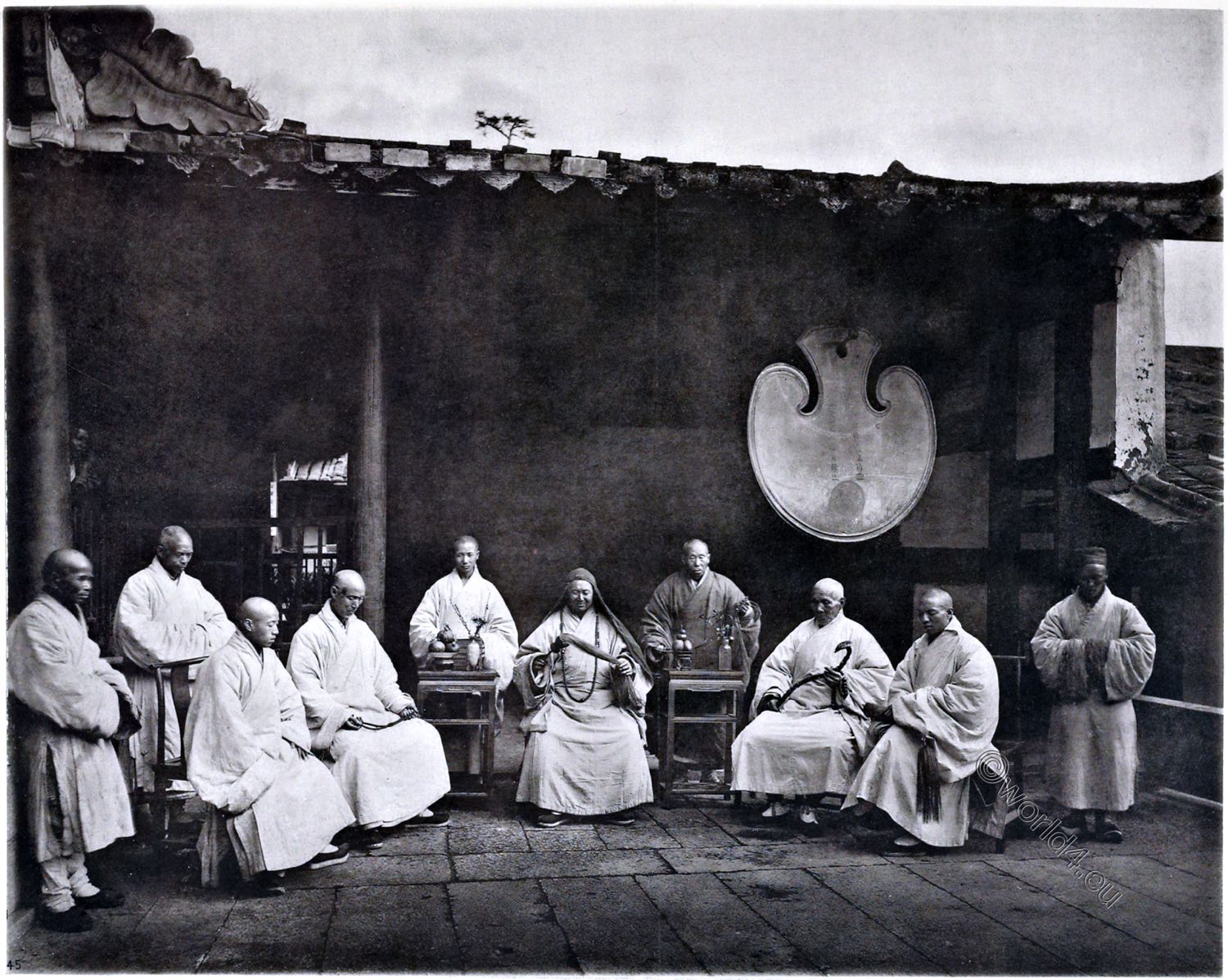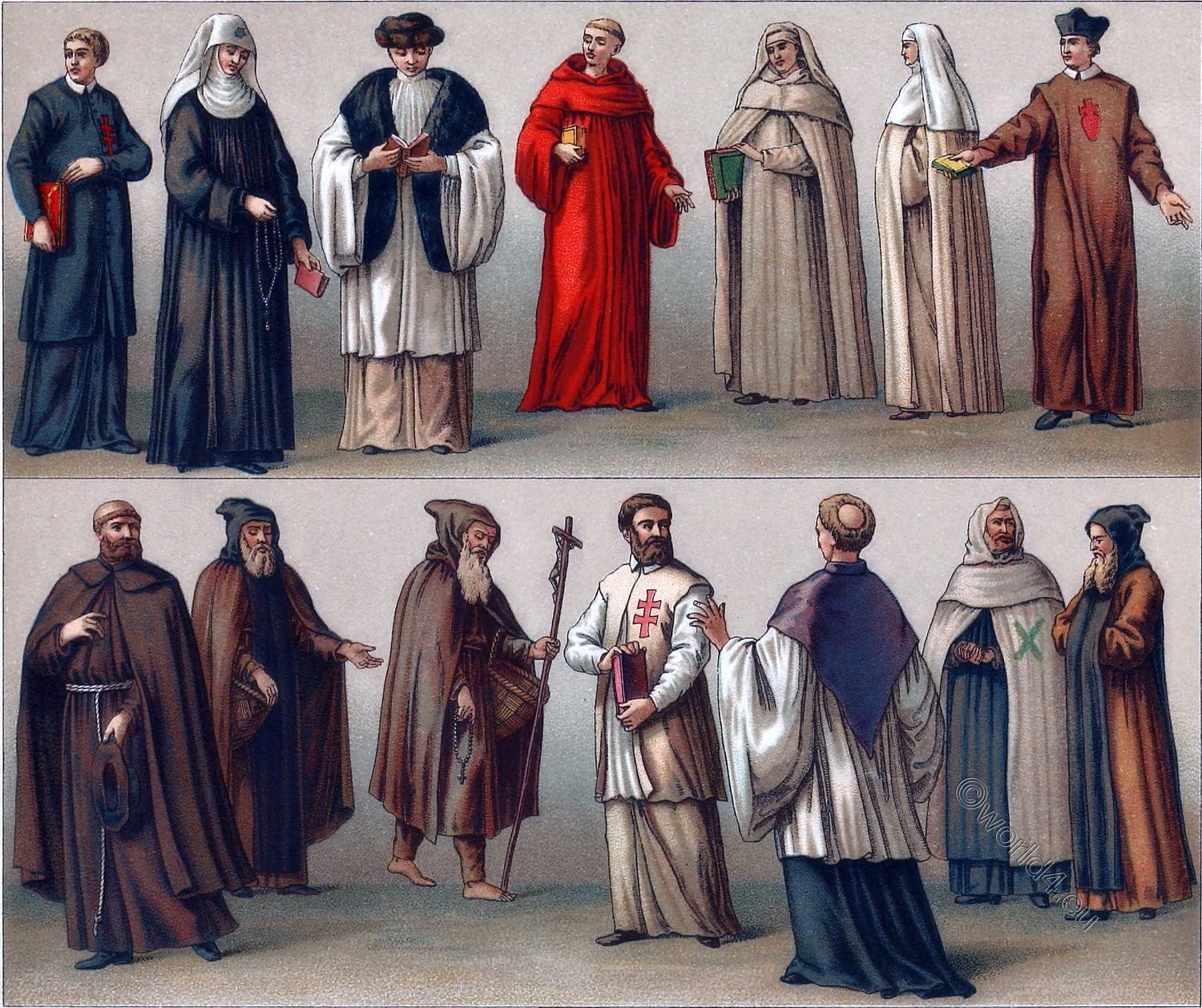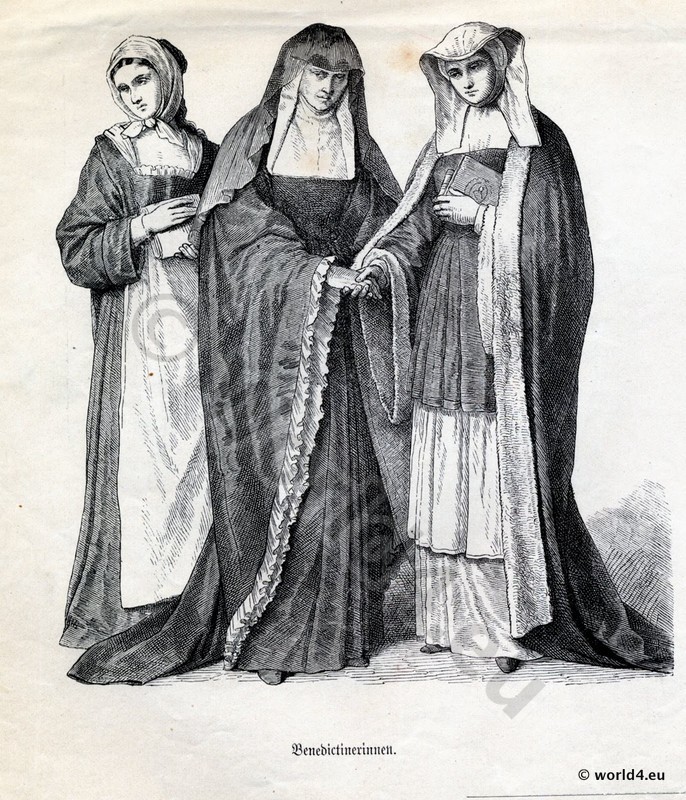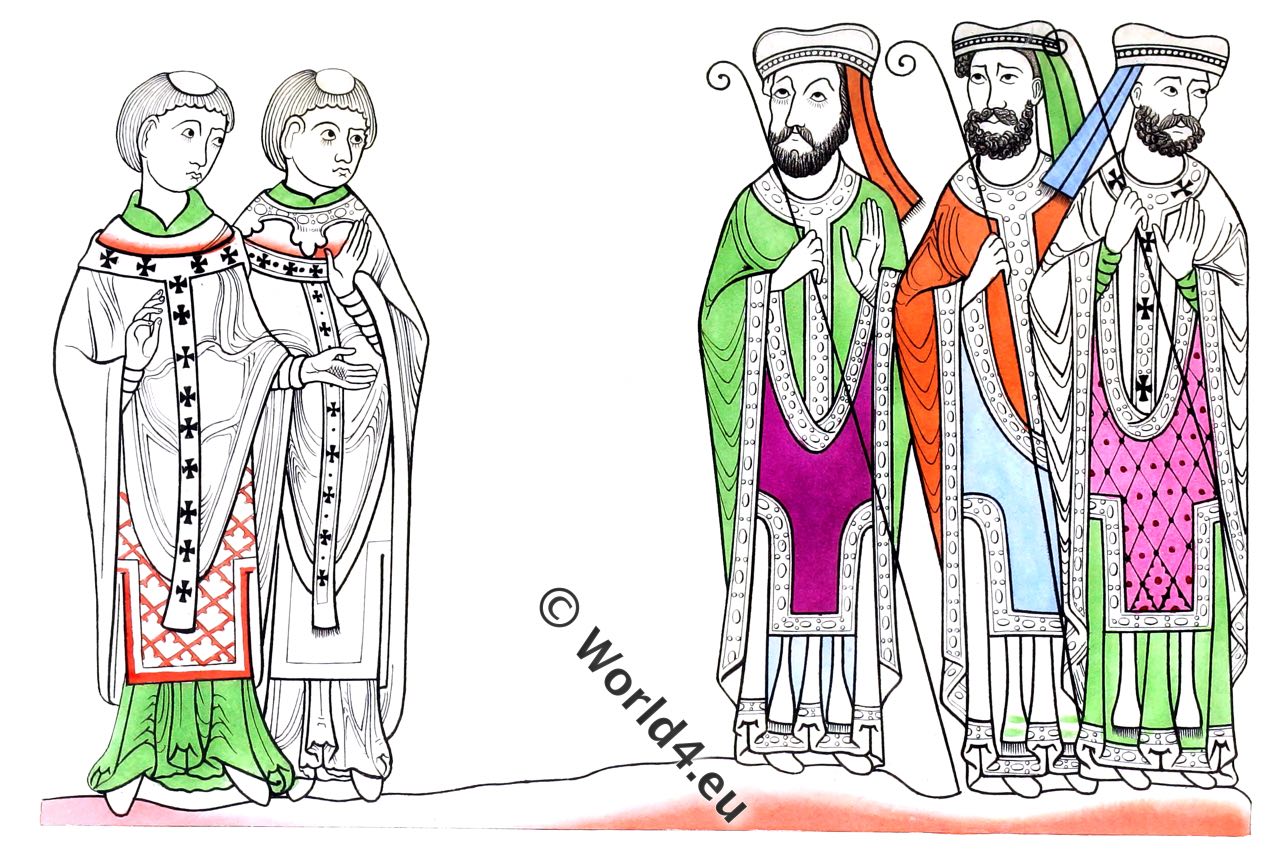
ORIENT. OLDER ORDERS OF MONKS AND NUNS.
Order costumes.
1 2 3 4 5 6 7 8
9 10 11 12 13 14
These oriental monastic and nun’s habit date back to the earliest times of Christianity. The illustrations and explanations are taken from the works of Father Hélyot, von Schoonebeck and de Bar.
No. 1.
Elder Templar in his ordinary dress.
Originally, the temple masters wore a white religious habit without a cross. The red cross was only added later. Only the knights of the order were allowed to wear the white dress, which was shortened by a belt during war. This spiritual order of knights was founded in Palestine in 1118.
Nos. 2 and 8.
Carmelites in their Syrian costume.
Carmelites are the members of the Order of the Brothers of the Blessed Virgin Mary of Mount Carmel (Latin: Ordo Fratrum Beatissimae Mariae Virginis de Monte Carmelo), which was founded around 1150 at Mount Carmel in the Holy Land and originates from the tradition of hermitism. The members of the women’s branch of the order, founded in the second half of the 15th century, are called Carmelites.
The Order split into Carmelites and Carmelite Nuns of the Old Observance and Discalced Carmelites and Discalced Carmelite Nuns during the reform movement of the 16th century.
Nos. 3 and 6.
Mingrelian monks in their ordinary house dress and winter garb.
Since the Georgians are said to have already accepted Christianity at the end of the first century, the foundation of the monastic orders may also date back to this time. The monks differ from the laity in their habit only in that they let their hair and beard grow. Their clothing consists of a shirt of coarse canvas tucked into tight leggings and a kind of short jacket or, depending on the season, a felt cloak worn like the chlamys of the ancients, by putting the head through the opening and turning it around according to the rain and wind.
They wear buffalo leather shoes and a black cap or a high mushroom cap with a flattened top. The monks of this order, which still exists, confine themselves to fasting and prayer and are said to be little respected except for those who lead the service.
No. 4.
Armenian monk of the Order of St. Anthony in Morea.
Morea (Gr. Μωρέας or Μωριάς) has been the Romanesque name of the Peloponnese peninsula (Greece) since the Middle Ages. The name is derived from a Greek word for mulberry tree, significant for the silk industry.
In 1206, the north-west of the region was conquered by participants of the Fourth Crusade, who founded the Principality of Achaia there. In 1262, large areas had to be ceded to the resurgent Byzantine Empire; in Laconia, the Byzantine despotate of Morea was subsequently formed around Mystras (Mistra) under the Kantakuzenoi and later the Palaiologi.
Over time, they were able to bring almost the entire peninsula under their control. Mistra, mostly a secondary nucleus of the imperial house, became a centre of late Byzantine culture. In addition, Venice had some possessions on the peninsula.
In 1453, the Ottoman Sultan Mehmed II offered the last Byzantine Emperor Constantine XI to keep control of the Morea if he surrendered Constantinople without a fight, which the latter refused, resulting in the conquest of Constantinople (1453), in which the Emperor fell. In 1460, Morea was also taken by the Ottomans under “Fatih” – “the Conqueror”.
After Greek independence in 1830 (unilaterally in 1822), the ancient name Peloponnese was preferred again, just as many place names were Hellenised. Thus, until the 19th century, today’s Pylos was called Navarino and the island of Euboea Negroponte.
No. 5.
Akoimetic or Studite monk; Syria.
The habit of the order is green in colour and distinguished by a red cross on the chest of the shoulder coat over the dress. The monks let their beard and hair grow long.
Acoemetae (also spelled Acoemeti or Akoimetoi in Greek: ἀκοίμητος, literally ‘insomniacs’) was an order of Eastern Christian monks (Greek or Basilian) who celebrated divine service without rest day or night. This was done by dividing the communities into choirs, which took turns in the church. The alternating choirs came in three groups by liturgical language: Greek, Latin and probably Syriac.
No. 7 Secular Canon of the Holy Sepulchre in Jerusalem.
Canons, also called choirmasters, are clerics of all orders, mostly of the Roman Catholic or Anglican Church, who participate in the common liturgy as members of a cathedral chapter or a collegiate chapter of a cathedral, basilica or religious church (regular canons).
Common liturgy means the celebration of Holy Mass and the Liturgy of the Hours, to which all priests are obliged, whether alone or in community.
This is also where the name “canon” comes from, which is derived from the ecclesiastical Latin term canonicus, which in turn goes back to the Greek (κανών “rule, standard” or κανονικός “regular, obligatory”).
The times of the “canonical hours” (horae canonicae), that is, those of the Liturgy of the Hours, have been circumscribed in the Occident since the middle of the 6th century by the Benedict Rule.
Canons live in community. The head of a chapter is usually a provost, sometimes the leadership is also assigned to a dean or prior.
Nos. 9 and 14.
Mingrelian (Landscape in western Georgia) and Georgian nuns.
The costume of these nuns differs only in its black colour from the usual women’s costume of the region, which follows the Persian one. Their short sleeveless skirt, worn in the same way by men, gives way in autumn to a longer one with sleeves and lined with fur. When they go out, they cover their faces with a white cloth covering their chin and forehead, with a gauze lattice between them.
Nos. 10 and 13.
Egyptian nuns. Oriental nuns from antiquity.
According to legend, this order was founded in Egypt in the third or fourth century by St. Syncletica. The costume of these nuns, whose existence, incidentally, has not been historically established, was compiled by Father Hélyot according to a treatise on virginity attributed to Athanasius.
No. 11.
Armenian nun.
An order which, according to legend, was founded by St. Gregory Illuminator at the beginning of the fourth century. This costume also differs in cut from the usual Armenian women’s clothing.
No. 12.
Maronite nun (Capuchin) in costume; Aleppo, Lebanon.
This order is said to have been founded around the middle of the 17th century. The nuns wore a skirt of brown cloth girded with a rope, a bib of white linen and a cloak of brown colour. When they went out, they wrapped themselves in a white veil that covered their figure from head to toe.
Source: History of Costume in Chronological Development by Auguste Racinet. Edited by Adolf Rosenberg. Berlin 1888.
Related

Discover more from World4 Costume Culture History
Subscribe to get the latest posts sent to your email.






